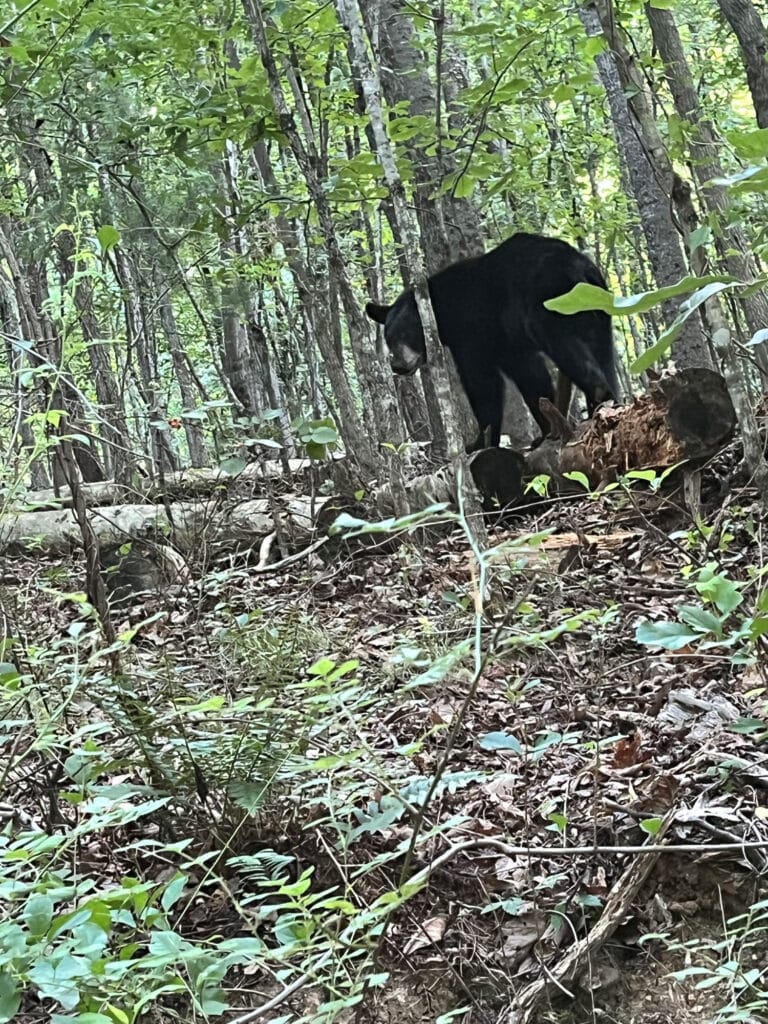We followed a trail along the James River, hiking parallel to train tracks and holding briars back for those behind us. These mixed landscapes are ideal for the clever coyotes captured on the trail camera we were headed toward. Anne Wright, assistant professor of ecology at Virginia Commonwealth University, and one of her students, Jack Ryan, changed the camera’s batteries as they explained the complex relationships comprising the ecosystem of Richmond’s James River Park System (JRPS).
“We’ve seen deer and squirrels so plentiful they deplete the batteries of the motion-triggered shutter, but coyotes are changing that,” explains Wright. She got interested in coyotes when they began showing up on her trail cameras two years ago.
Her Game Camera Project of Science in the Park launched in 2014 and documents wildlife to discover more about the species which call JRPS home. These cameras and other evidence suggests that at least one pack of coyotes lives in the Park System. After coyotes purportedly killed a dog in nearby Forest Hill neighborhood last year, the community organized a meeting between officials, scientists, and concerned citizens to discuss the issue. Coyote management and conservation are a hot topic as their populations rise throughout the east coast.
“An urban park system like JRPS is an oasis for them,” Wright says. Food is plentiful and easy, humans can’t hunt them, and their historic predators like wolves and cougars are absent.
The only canine endemic to North America, coyotes have called this continent home for over a million years. Totemic symbols of cunning, mischievous intelligence, coyotes have been drawn eastward in the past half-century to fill the niche left by the nearly-extinct red wolf.
Over time, coyotes have bred with other canines, creating animals with varying ratios of coyote, wolf, and dog DNA, and giving rise to what some call “coywolves” or “coydogs.” While not distinct species, genetic analysis has prompted scientists to call the emerging hybrids the eastern coyote.
Unlike wolves, coyotes quickly adapt to shifting environmental pressures and have some of the most varied diets of any canine, making them well-suited to the eastern forests, suburbs, and even cities of the Blue Ridge. “Coyotes are true foragers and will eat small animals, eggs, fruit, grass, insects, and roadkill,” says Wright. The work of Dr. Marcella Kelly, a researcher for the Virginia Department of Fish and Wildlife Conservation, aligns with this.
Dr. Kelly’s team conducted a study on coyote population dynamics which was published in The Journal of Wildlife Management in 2016. While opportunist coyotes scavenge on carcasses and get into trash, they also survive on berries, nuts, and other plant matter. Still, they are skilled predators serving important ecological niches that have been absent in eastern mountains for quite awhile. While humans have eradicated most natural controls for prey such as deer, rodents, and rabbits, coyotes keep these and feral cat populations in check.
The trouble lies when coyotes find easy prey in farmlands and pastures. Lisbeth Rasmussen and her partner Joe operate Split Acre Farm in Rougemont, N.C. Over one hundred acres of forest surrounds the farm, and every night they hear the unmistakable howl that Dan Flores called America’s “original national anthem” in his book Coyote America. Before Split Acre, Rasmussen worked land near Hillsborough for three years, where coyotes frequently helped themselves to livestock, including turkey hatchlings, piglets, and even a yearling steer.
As agricultural land transitions to suburban developments, coyotes have been pushed into new habitat and forced to adapt. Rasmussen has seen increased evidence of coyotes on her own trail cams as surrounding forests and fields give way to neighborhoods. “They’re the same as deer in that if you take away their home, they’ll move into yours,” she says. In her experience, successful mitigation efforts include increasing fence height and voltage and utilizing guard dogs.
Virginia native Don Shumaker, lifelong hunter and trapper and author of Journals of a Coyotero, argues that coyote culls are necessary to manage coyotes. “There’s a growing need for systematic, widespread control,” he says. Shumaker is adamantly opposed to poison, which takes unintended casualties and releases toxins into the ecosystem; he maintains that subcontracted hunters and trappers with government assistance and oversight is the best management policy. By infringing upon this territorial predator’s habitat, “humans threw things out of balance,” he says. “It’s our duty to try to get it back in sync in the best way possible.”
But Dr. Kelly’s work demonstrates coyotes’ ability to self-regulate: “I think one problem is there are almost no populations in the U.S. that are not hunted, making comparison difficult, but the evidence is pretty clear that bounties and culls do a poor job at decreasing coyote populations due to their density-dependent responses.”
One of these responses is birth rate, meaning that if local coyote numbers drop, litters will be larger the following spring. A factor like food surplus triggers bigger litters whose numbers will help fill out the territory. Her study suggests that density-dependent birth and mortality rates should be considered when devising coyote management objectives. Says Kelly, “This is an incredibly malleable and flexible species that is not generally known as a mountain animal, yet here it is.”








